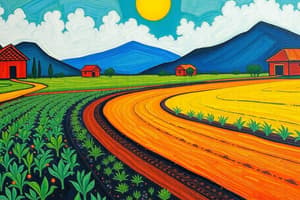Podcast
Questions and Answers
What are the primary sources of food for humans and animals?
What are the primary sources of food for humans and animals?
Farming
What are the different types of farms mentioned in the text?
What are the different types of farms mentioned in the text?
Intensive, extensive, and organic farms
What is the focus of intensive farms?
What is the focus of intensive farms?
Maximizing production
What method do extensive farms rely on for natural pest control?
What method do extensive farms rely on for natural pest control?
What is urban agriculture?
What is urban agriculture?
What is aquaculture?
What is aquaculture?
What is precision farming also known as?
What is precision farming also known as?
What is agroforestry?
What is agroforestry?
What are the advantages of organic farming?
What are the advantages of organic farming?
What is the main goal of understanding the different types of farms and their impacts?
What is the main goal of understanding the different types of farms and their impacts?
Flashcards are hidden until you start studying
Study Notes
Sourcing Food: A Focus on Farming
Farming is one of the primary sources of food for humans and animals. It involves the production of food, feed, fuel, and fiber through the cultivation of crops and the raising of livestock. There are different types of farms, including intensive, extensive, and organic farms. Each type uses different methods to produce food, which can have varying environmental impacts.
Intensive Farms
Intensive farms are also known as industrial farms or factory farms. They focus on maximizing production by using large amounts of inputs, such as fertilizers, pesticides, and irrigation. This method allows for higher crop yields and efficiency, but it can have negative environmental impacts, such as soil degradation and water pollution.
Extensive Farms
Extensive farms, on the other hand, prioritize environmental sustainability over productivity. These farms use fewer inputs and rely more on natural processes, such as crop rotation and natural pest control. This method can result in healthier soil and reduced environmental impact, but it may not produce as much food as intensive farms.
Organic Farms
Organic farms adhere to strict regulations regarding the use of pesticides, fertilizers, and other inputs. They prioritize environmental sustainability and animal welfare, but their production costs are often higher than conventional farms. Despite this, organic farms have grown in popularity due to consumer demand for healthier and more sustainable food options.
Aquaculture
Aquaculture, also known as fish farming, is another important source of food. It involves the cultivation of fish and other aquatic species in controlled environments or in the wild. This method can provide a sustainable source of animal protein, but it can also have negative impacts on the environment if not managed properly.
Urban Agriculture
Urban agriculture is the practice of growing food in urban environments, such as rooftops, community gardens, and vertical farms. This method can provide fresh, locally grown food for urban residents and reduce the environmental impact of transporting food over long distances.
Precision Farming
Precision farming, also known as precision agriculture, is the use of technology, such as GPS, drones, and sensors, to optimize crop production and reduce input costs. This method can increase efficiency and profitability, while also reducing the environmental impact of farming.
Agroforestry
Agroforestry is a land-use system that combines agriculture and forestry. It involves growing crops and trees together on the same land, which can provide multiple benefits, such as increased biodiversity, improved soil health, and reduced risk of crop failure.
In conclusion, farming is a crucial source of food that encompasses various methods and practices. Each type of farm has its own advantages and disadvantages, and it is essential to consider these factors when making decisions about food production and distribution. By understanding the different types of farms and their impacts, we can work towards a more sustainable and equitable food system.
Studying That Suits You
Use AI to generate personalized quizzes and flashcards to suit your learning preferences.




